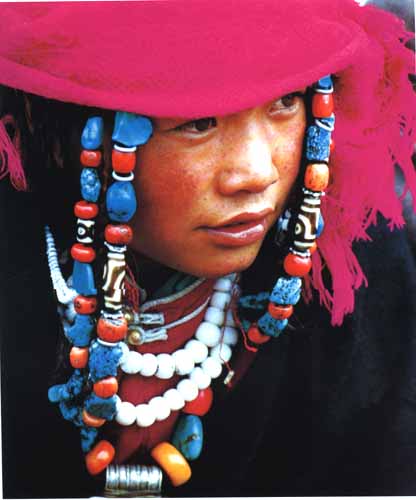
The basic features of Tibetan costume existed before the Tibetans emerged as a race.
Archaeological findings show that the Qiangs, which later became part of the Tibetans, once lived in Sichuan, Qinghai, Gansu and Xinjiang regions. Historically, the Qiangs in Gansu and Qinghai and local inhabitants in Tibet had frequent cultural exchanges and often migrated to each other's areas.
The dry corpses discovered in a cemetery of a primitive commune in Hami, Xinjiang, which is near Qinghai Plateau, can be dated back to 3,000 years ago. When unearthed, the hair of the corpses was plaited, the male wearing fur-coat and high boots. Their clothes share the costume style of the Tibetans.
Their hairdo belong to the same category as that of the Qiangs recorded in documents. Their costume and ornaments can serve as important references for the origin of Tibetan costume and ornaments. It can be logically induced that as far back as 3,000 years ago,the costume and ornaments of the tribes and races as ancestors of the Tibetan had the basic features of the later Tibetan costume and ornaments.
The most striking feature of Tibetan costume and ornaments is its large variety, including silk robes, sleeveless robes, jackets, waistbands, hats, boots, aprons, hairdos and ornaments on the head and on the body. In terms of quality, the robes can be divided into brocade robe, silk robe, embroidered silk robe, jacquard leather robe, leather robe with fancy lace, leather robe with plain lace, leather robe with leopard skin lace, animal skin robe, pulu robe,
lined woolen robe and cotton cloth robe.
In terms of local feature, there are the pasture leather robe, robe with fancy lace, and pulu robe of the agricultural area. In terms of style, there are the long-sleeved leather robe, Gangbung broad-shouldered sleeveless robe, sleeveless robe for women and Jialuo fancy-collared pulu robe.
Tibetan costume and ornaments are closely associated with productive labor and many ornaments, which still have dual function of ornamentation and practical purpose, have taken shape gradually from practical usage in work or life. In North Tibet, the altitude is high and the weather cold. The period is long when the ground is covered with ice and snow. The annual average temperature is low and the temperature does not vary much throughout the year. Even in the
hottest month of July, there is frost at night. The difference in temperature between day and night is great, however.
But the vast area in North Tibet is grassland, natural pasture since ancient times. The Tibetan inhabitants here should have clothes easy for travelling as well as for their daily lives, capable of protecting themselves from the cold and dissipating heat. The robes of the herdsmen here are loose enough to serve as a quilt at night and allow the free movement of the arms during the day. When the ample sunshine raises the temperature, they can easily free one arm from the sleeve to help adjust the body temperature. By and by, the way to wear a robe with one arm stripped has become a symbol of the Tibetans' uninhibited character.
In terms of the application of colors, Tibetan costume and ornaments feature sharp contrasts as well as a harmony. Many white pulu robes have black neckband, wristband and lower hem, the width of which can reach a foot. To give prominence to the black hem, white trousers are worn.
Binding materials and clothes are often in contrastive colors. Women often use woolen threads of contrastive colors, such as bright red and emerald green, vermillion and ultramarine, pink and azure, as ornaments for their hair. The robes in Qamdo Area are colorful, such blue robes with a red belt. Gold and silver colors and multicolor are used together with colors of sharp contrast to obtain a harmonious effect in the color arrangement of the robes.
The gold thread brocade on the Gold Flower hat, the gold and silver hem of Gangbung hat, the colored pulu on songba and galuo Boots and the gold thread rim of jialao (colored lace) are all examples of the color arrangement, which are harmonious and uniform and at the same time give the costume a gorgeous and resplendent national feature.
A more typical example for the application of colors is the women's bangdian (apron). On this unique article of Tibetan costume, numerous folk artists have demonstrated their outstanding ability. Some bangdian use broad color strips of sharp contrast, bold and vivacious.
Some use fine strips of related warm colors, looking elegant and refined. Some have primary color or black or white thread among the multicolor strips.Some use a single color phase as the keynote to form uniform colors of purplish red, reddish brown and greenish lime.
As to the successive matching of color strips, some organize the patterns into groups in a progressive manner while others just apply a mixed arrangement. All the narrow or broad strips, the bright or dark colors, the change of co1or phases and the matching of primary with secondary colors are bold, elegant and artistically unique.
